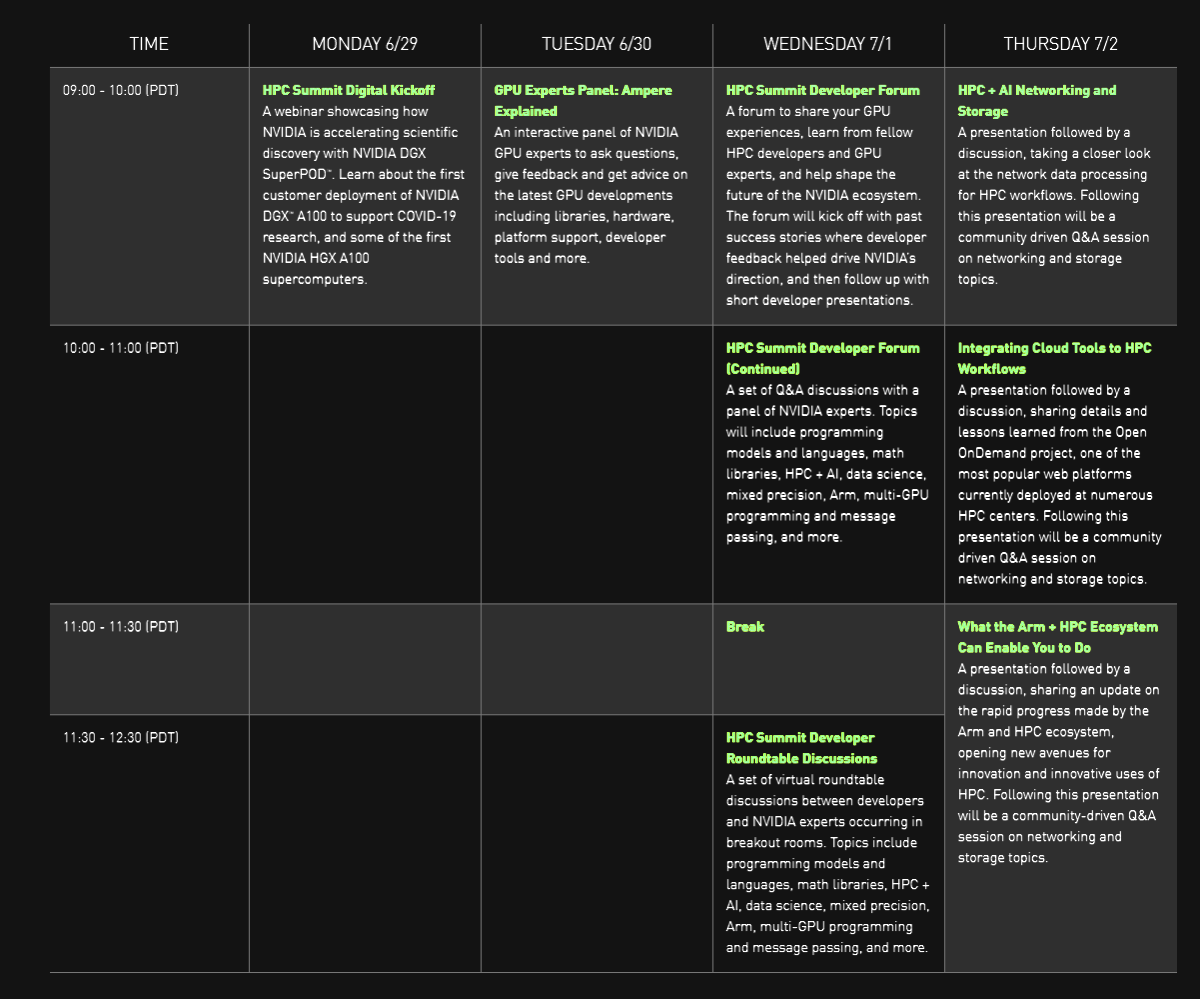Two virtual events this month aim to drive scientific computing forward, inspired in no small part by the race against the coronavirus.
The ISC High Performance 2020 Digital (June 22-25) and NVIDIA’s HPC Summit Digital (June 29-July 2) offer insights on the latest tools and techniques taking science and research into the next era of scientific computing. Both online events are free.
Talks, panels and demos will describe new accelerated systems and networks and how they are being applied across fields from astrophysics to quantum mechanics. The fight against COVID-19 will be front and center.
While the pandemic prevents the HPC community from gathering in person, the two events help scientists, researchers and engineers collaborate. So set some time aside on your calendar and register for ISC Digital, explore NVIDIA’s activities at ISC Digital and register for the HPC Summit Digital.
ISC and the HPC Summit also mark the first time experts from NVIDIA and Mellanox will present as part of a single company after completing a merger on April 27. They will share perspectives on what the combination of data center acceleration and advanced networking means for HPC.
HPC+AI: A New Pillar of Scientific Discovery
In other hot topics, ISC and the HPC Summit will shed light on increasing efforts that fuse HPC with AI.
The combination, already in use at several supercomputing centers, promises to accelerate simulations, shortening the time to scientific results. It’s one of many ways HPC is delivering gains in performance and power-efficiency.
At both events, NVIDIA experts will be on hand to answer questions and give updates on two major milestones.
The NVIDIA Ampere architecture, announced May 14, packs tensor core acceleration for FP64 operations and other features aimed to speed scientific applications. NVIDIA A100 GPUs come to the events with an expanding set of use cases, partners and form factors.
Supercomputer Centers Collaborate on COVID
The virtual festivities kick off with ISC, Europe’s annual supercomputing event. On its opening day, a leader from Argonne National Laboratory — a member of the COVID-19 High Performance Computing Consortium formed by the U.S. White House — will join others from Europe and Asia to describe their efforts.
The consortium is providing access to 30 supercomputers with more than 50,000 GPUs and has been described as “the Apollo program of our time … not a race to the moon, but a race for humanity.”
Argonne is the first of six supercomputing centers worldwide to apply NVIDIA’s new A100 GPUs to work seeking vaccines and treatments for the virus.
In one of 63 active projects supported by the consortium, researchers at Oak Ridge National Laboratory recently harnessed GPU accelerators in the Summit supercomputer. They hope to analyze as many as 2 billion compounds in 24 hours in the search for drugs to neutralize the coronavirus.
Inside a 700-Petaflops DGX SuperPOD
At ISC’s vendor-showdown session and exhibitor forum, speakers including Marc Hamilton, vice president of solutions architecture and engineering at NVIDIA and Gilad Shainer, senior vice president of marketing for Mellanox networking at NVIDIA, will describe new technologies, such as the latest DGX SuperPOD.
The system sports a peak 700 petaflops to train AI models once thought beyond reach. It packs 1,120 A100 GPUs linked with 170 NVIDIA Mellanox HDR 200G InfiniBand switches that support in-network computing engines.
In a June 23 ISC session, NVIDIA will describe SHARP, an acceleration engine for offloading networking tasks from the CPU or the GPU to the InfiniBand switch network. In tests on a system using HDR 200G InfiniBand, it delivered about 96 percent of point-to-point bandwidth while increasing AI performance on PyTorch.
HPC Summit Covers A100 and More
The HPC Summit Digital, a forum for the HPC community hosted by NVIDIA, kicks off Monday, June 29. Ian Buck, the developer of CUDA and general manager of NVIDIA’s accelerated computing group, and Michael Kagen, co-founder of Mellanox and now CTO of NVIDIA’s Mellanox networking business unit will speak at the opening session.
They’ll talk about the first HPC centers using NVIDIA DGX A100 systems to support COVID-19 research, as well as the first NVIDIA HGX A100 supercomputers.
The following Tuesday, GPU and software experts will convene a roundtable and Q&A session to discuss NVIDIA’s Ampere architecture. They’ll provide details and take questions on the A100 and its platforms, libraries and developer tools and how they can advance HPC, AI and data science.
A three-hour developer forum on Wednesday, July 1, will start with descriptions of success stories, lessons learned and developers’ top requests. The forum also includes a Q&A session with NVIDIA experts and roundtable discussions in virtual breakout rooms on topics such as:
- Parallel computing programming models and languages
- Math libraries
- HPC+AI
- Data analytics
- Mixed-precision computing
- GPU acceleration for Arm
- Multi-GPU programming
- Message passing
The HPC Summit wraps up Thursday, July 2, with three sessions on topics of interest for HPC data centers. Each will start with an expert talk and include a Q&A.
The day begins with a session on networking and storage, especially for emerging HPC+AI use cases. A session on HPC cloud tools follows with a talk on the Open OnDemand project for accessing supercomputers from Alan Chalker, a director from the Ohio Supercomputer Center.
The third session of the day explores the state and outlook for Arm’s processor technology in HPC. Brent Gorda, senior director for HPC at Arm, will give a state of the union address on the Arm ecosystem in HPC and take feedback on future directions.
It’s an initiative NVIDIA officially joined when it announced last year support for CUDA on Arm, attracting many new partners into the fold.
For more details, see the full HPC Summit Digital schedule.
